Variable Circular Polarizers

- Creates Circularly Polarized Output
- Wave Plate can be Rotated to Output Linear or Elliptical Polarization
- 30 mm Cage and SM1 Lens Tube Compatible
VC5-1064
Cubes Feature an
Engraved Beam Diagram

Please Wait
Features
- Generate Circularly, Elliptically, or Linearly Polarized Light from an Unpolarized or P-Polarized Input Beam
- Polarizing Beamsplitter and Rotating Quarter-Wave Plate
- Design Wavelengths: 532, 633, 780, 1064, or 1550 nm
- Ø10 mm Clear Aperture
- Compatible with Ø1" Lens Tubes and 30 mm Cage System
- SM1-Threaded (1.035"-40) Input Port and SM05-Threaded (0.535"-40) Output Port
- Connect Two Cage Cubes Side by Side with the CM1-CC Cage Cube Connector
These Variable Circular Polarizing Cubes are comprised of a polarizing beamsplitter cube and a quarter-wave plate, both housed in a 30 mm cage cube. The assembly comes prealigned to produce right-hand circular polarization from an unpolarized or p-polarized input beam (relative to the beamsplitting plane). These cubes can also function as a polarization controller by unlocking and rotating the quarter-wave plate. A variety of circular, elliptical, or linear polarization states can then be generated (see the Polarization Control tab for details).
The imperial versions of these variable circular polarizers feature laser-line beamsplitter cubes with a 3000:1 extinction ratio and Rabs <0.25% per surface at the design wavelength. The metric versions are equipped with broadband beamsplitter cubes that offer an 1000:1 extinction ratio and Ravg <0.50% per surface over the AR coating range. The mechanical housing for these optics limits the clear aperture to Ø10.0 mm.
Cage System Compatibility
Each cube has four 4-40 tapped holes on all four faces for compatibility with our 30 mm cage system. Additionally, three faces have SM1 (1.035"-40) threading for use with Ø1" lens tubes, while the output port has SM05 (0.535"-40) threading for use with Ø1/2" lens tubes. Please note that the SM05-threaded section rotates with the wave plate. A bottom-located 8-32 (M4) tap is included for post mounting. These cage cubes can be connected to other cage cubes through the use of our cage rods and ERSCB adapters or can be connected side-by-side using our CM1-CC connector. The CM1-CC cage cube connector can be used on any face other than the one with the rotation mount.
Other Cage Cube Options
Each beamsplitter cube is epoxied within the cage cube mount and cannot be removed from the mount. However, Thorlabs also offers empty compact 30 mm cage cubes for mounting a variety of different cube-shaped optics or prisms. Our empty cubes have four SM1-threaded ports, with options available for having up to two Ø1/2" rotation mounts premounted on different faces of the cube. Additional cube-compatible SM1-threaded Ø1/2" rotation mounts are also offered separately. For a complete selection of our 30 mm cage-cube-mounted optics, please see the Mounted Optics Guide tab.
The rotation mount on the front of these cubes houses the quarter-wave plate. The cubes are shipped with the rotation mount prealigned and locked so that the outputted light has a right-handed, circular polarization. However, by loosening the setscrew on the side of the rotation mount (0.035" hex, hex key included), the wave plate can be rotated to produce a number of different output polarization states. In the chart below, the rotation mount is rotated the given number of degrees on the engraved scale, starting at the factory-aligned right-hand circular polarization state. For rotation angles from 180° to 360°, add 180° to the numbers shown.
Note: The factory-aligned, right-handed, circularly polarized output corresponds to a given angle on the rotation mount's engraved scale; this angle may vary between individual polarizer cubes. Before rotating the wave plate, please record the angle at which the cube was aligned to provide right-handed circularly polarized output, both as a guide to produce the polarization states below as well as a way to easily return the cube to the factory settings.
| Wave Plate Rotation Anglea |
Vector Diagram | Wave Plate Rotation Anglea |
Vector Diagram |
|---|---|---|---|
| Right-Hand Circular | Left-Hand Circular | ||
| 0° (Factory Aligned, See Note Above) |
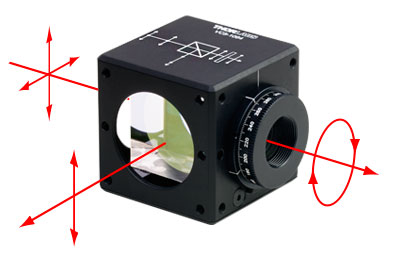 |
90° | 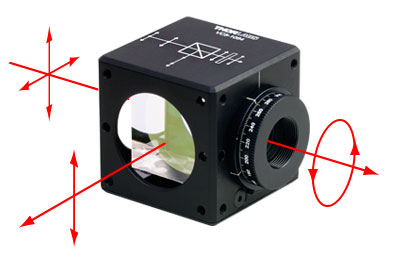 |
| Elliptical | Elliptical | ||
| 22.5° | 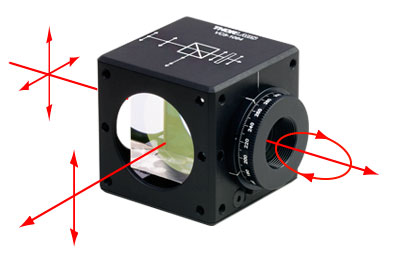 |
112.5° | 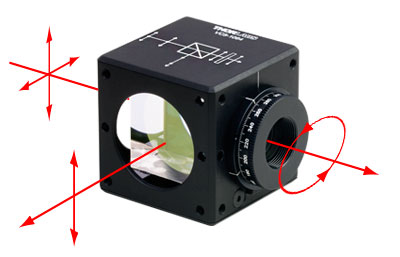 |
| Linear Horizontal (P) | Linear Horizontal (P) | ||
| 45° | 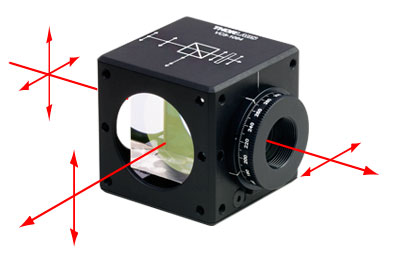 |
135° |  |
| Elliptical | Elliptical | ||
| 67.5° | 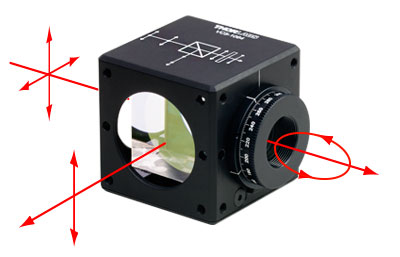 |
157.5° |  |
| Table 3.1 Specifications | |
|---|---|
| Item # | Damage Threshold |
| VC5-532(/M) | 2 J/cm2 at 532 nm, 10 ns, 10 Hz, Ø0.803 mm |
| VC5-633(/M) | 2 J/cm2 at 532 nm, 10 ns, 10 Hz, Ø0.803 mm |
| VC5-780(/M) | 2 J/cm2 at 810 nm, 10 ns, 10 Hz, Ø0.166 mm |
| VC5-1064(/M) | 2 J/cm2 at 1064 nm, 10 ns, 10 Hz, Ø0.484 mm |
| VC5-1550(/M) | 5 J/cm2 at 1542 nm, 10 ns, 10 Hz, Ø0.181 mm |
Damage Threshold Data for Thorlabs' Circular Polarizing Cubes
The specifications in Table 3.1 are measured data for Thorlabs' Circular Polarizing Cubes. These damage thresholds are limited by the beamsplitter cubes.
Laser Induced Damage Threshold Tutorial
The following is a general overview of how laser induced damage thresholds are measured and how the values may be utilized in determining the appropriateness of an optic for a given application. When choosing optics, it is important to understand the Laser Induced Damage Threshold (LIDT) of the optics being used. The LIDT for an optic greatly depends on the type of laser you are using. Continuous wave (CW) lasers typically cause damage from thermal effects (absorption either in the coating or in the substrate). Pulsed lasers, on the other hand, often strip electrons from the lattice structure of an optic before causing thermal damage. Note that the guideline presented here assumes room temperature operation and optics in new condition (i.e., within scratch-dig spec, surface free of contamination, etc.). Because dust or other particles on the surface of an optic can cause damage at lower thresholds, we recommend keeping surfaces clean and free of debris. For more information on cleaning optics, please see our Optics Cleaning tutorial.
Testing Method
Thorlabs' LIDT testing is done in compliance with ISO/DIS 11254 and ISO 21254 specifications.
First, a low-power/energy beam is directed to the optic under test. The optic is exposed in 10 locations to this laser beam for 30 seconds (CW) or for a number of pulses (pulse repetition frequency specified). After exposure, the optic is examined by a microscope (~100X magnification) for any visible damage. The number of locations that are damaged at a particular power/energy level is recorded. Next, the power/energy is either increased or decreased and the optic is exposed at 10 new locations. This process is repeated until damage is observed. The damage threshold is then assigned to be the highest power/energy that the optic can withstand without causing damage. A histogram such as that below represents the testing of one BB1-E02 mirror.

The photograph above is a protected aluminum-coated mirror after LIDT testing. In this particular test, it handled 0.43 J/cm2 (1064 nm, 10 ns pulse, 10 Hz, Ø1.000 mm) before damage.

| Example Test Data | |||
|---|---|---|---|
| Fluence | # of Tested Locations | Locations with Damage | Locations Without Damage |
| 1.50 J/cm2 | 10 | 0 | 10 |
| 1.75 J/cm2 | 10 | 0 | 10 |
| 2.00 J/cm2 | 10 | 0 | 10 |
| 2.25 J/cm2 | 10 | 1 | 9 |
| 3.00 J/cm2 | 10 | 1 | 9 |
| 5.00 J/cm2 | 10 | 9 | 1 |
According to the test, the damage threshold of the mirror was 2.00 J/cm2 (532 nm, 10 ns pulse, 10 Hz, Ø0.803 mm). Please keep in mind that these tests are performed on clean optics, as dirt and contamination can significantly lower the damage threshold of a component. While the test results are only representative of one coating run, Thorlabs specifies damage threshold values that account for coating variances.
Continuous Wave and Long-Pulse Lasers
When an optic is damaged by a continuous wave (CW) laser, it is usually due to the melting of the surface as a result of absorbing the laser's energy or damage to the optical coating (antireflection) [1]. Pulsed lasers with pulse lengths longer than 1 µs can be treated as CW lasers for LIDT discussions.
When pulse lengths are between 1 ns and 1 µs, laser-induced damage can occur either because of absorption or a dielectric breakdown (therefore, a user must check both CW and pulsed LIDT). Absorption is either due to an intrinsic property of the optic or due to surface irregularities; thus LIDT values are only valid for optics meeting or exceeding the surface quality specifications given by a manufacturer. While many optics can handle high power CW lasers, cemented (e.g., achromatic doublets) or highly absorptive (e.g., ND filters) optics tend to have lower CW damage thresholds. These lower thresholds are due to absorption or scattering in the cement or metal coating.

LIDT in linear power density vs. pulse length and spot size. For long pulses to CW, linear power density becomes a constant with spot size. This graph was obtained from [1].

Pulsed lasers with high pulse repetition frequencies (PRF) may behave similarly to CW beams. Unfortunately, this is highly dependent on factors such as absorption and thermal diffusivity, so there is no reliable method for determining when a high PRF laser will damage an optic due to thermal effects. For beams with a high PRF both the average and peak powers must be compared to the equivalent CW power. Additionally, for highly transparent materials, there is little to no drop in the LIDT with increasing PRF.
In order to use the specified CW damage threshold of an optic, it is necessary to know the following:
- Wavelength of your laser
- Beam diameter of your beam (1/e2)
- Approximate intensity profile of your beam (e.g., Gaussian)
- Linear power density of your beam (total power divided by 1/e2 beam diameter)
Thorlabs expresses LIDT for CW lasers as a linear power density measured in W/cm. In this regime, the LIDT given as a linear power density can be applied to any beam diameter; one does not need to compute an adjusted LIDT to adjust for changes in spot size, as demonstrated by the graph to the right. Average linear power density can be calculated using the equation below.

The calculation above assumes a uniform beam intensity profile. You must now consider hotspots in the beam or other non-uniform intensity profiles and roughly calculate a maximum power density. For reference, a Gaussian beam typically has a maximum power density that is twice that of the uniform beam (see lower right).
Now compare the maximum power density to that which is specified as the LIDT for the optic. If the optic was tested at a wavelength other than your operating wavelength, the damage threshold must be scaled appropriately. A good rule of thumb is that the damage threshold has a linear relationship with wavelength such that as you move to shorter wavelengths, the damage threshold decreases (i.e., a LIDT of 10 W/cm at 1310 nm scales to 5 W/cm at 655 nm):

While this rule of thumb provides a general trend, it is not a quantitative analysis of LIDT vs wavelength. In CW applications, for instance, damage scales more strongly with absorption in the coating and substrate, which does not necessarily scale well with wavelength. While the above procedure provides a good rule of thumb for LIDT values, please contact Tech Support if your wavelength is different from the specified LIDT wavelength. If your power density is less than the adjusted LIDT of the optic, then the optic should work for your application.
Please note that we have a buffer built in between the specified damage thresholds online and the tests which we have done, which accommodates variation between batches. Upon request, we can provide individual test information and a testing certificate. The damage analysis will be carried out on a similar optic (customer's optic will not be damaged). Testing may result in additional costs or lead times. Contact Tech Support for more information.
Pulsed Lasers
As previously stated, pulsed lasers typically induce a different type of damage to the optic than CW lasers. Pulsed lasers often do not heat the optic enough to damage it; instead, pulsed lasers produce strong electric fields capable of inducing dielectric breakdown in the material. Unfortunately, it can be very difficult to compare the LIDT specification of an optic to your laser. There are multiple regimes in which a pulsed laser can damage an optic and this is based on the laser's pulse length. The highlighted columns in the table below outline the relevant pulse lengths for our specified LIDT values.
Pulses shorter than 10-9 s cannot be compared to our specified LIDT values with much reliability. In this ultra-short-pulse regime various mechanics, such as multiphoton-avalanche ionization, take over as the predominate damage mechanism [2]. In contrast, pulses between 10-7 s and 10-4 s may cause damage to an optic either because of dielectric breakdown or thermal effects. This means that both CW and pulsed damage thresholds must be compared to the laser beam to determine whether the optic is suitable for your application.
| Pulse Duration | t < 10-9 s | 10-9 < t < 10-7 s | 10-7 < t < 10-4 s | t > 10-4 s |
|---|---|---|---|---|
| Damage Mechanism | Avalanche Ionization | Dielectric Breakdown | Dielectric Breakdown or Thermal | Thermal |
| Relevant Damage Specification | No Comparison (See Above) | Pulsed | Pulsed and CW | CW |
When comparing an LIDT specified for a pulsed laser to your laser, it is essential to know the following:

LIDT in energy density vs. pulse length and spot size. For short pulses, energy density becomes a constant with spot size. This graph was obtained from [1].
- Wavelength of your laser
- Energy density of your beam (total energy divided by 1/e2 area)
- Pulse length of your laser
- Pulse repetition frequency (prf) of your laser
- Beam diameter of your laser (1/e2 )
- Approximate intensity profile of your beam (e.g., Gaussian)
The energy density of your beam should be calculated in terms of J/cm2. The graph to the right shows why expressing the LIDT as an energy density provides the best metric for short pulse sources. In this regime, the LIDT given as an energy density can be applied to any beam diameter; one does not need to compute an adjusted LIDT to adjust for changes in spot size. This calculation assumes a uniform beam intensity profile. You must now adjust this energy density to account for hotspots or other nonuniform intensity profiles and roughly calculate a maximum energy density. For reference a Gaussian beam typically has a maximum energy density that is twice that of the 1/e2 beam.
Now compare the maximum energy density to that which is specified as the LIDT for the optic. If the optic was tested at a wavelength other than your operating wavelength, the damage threshold must be scaled appropriately [3]. A good rule of thumb is that the damage threshold has an inverse square root relationship with wavelength such that as you move to shorter wavelengths, the damage threshold decreases (i.e., a LIDT of 1 J/cm2 at 1064 nm scales to 0.7 J/cm2 at 532 nm):

You now have a wavelength-adjusted energy density, which you will use in the following step.
Beam diameter is also important to know when comparing damage thresholds. While the LIDT, when expressed in units of J/cm², scales independently of spot size; large beam sizes are more likely to illuminate a larger number of defects which can lead to greater variances in the LIDT [4]. For data presented here, a <1 mm beam size was used to measure the LIDT. For beams sizes greater than 5 mm, the LIDT (J/cm2) will not scale independently of beam diameter due to the larger size beam exposing more defects.
The pulse length must now be compensated for. The longer the pulse duration, the more energy the optic can handle. For pulse widths between 1 - 100 ns, an approximation is as follows:

Use this formula to calculate the Adjusted LIDT for an optic based on your pulse length. If your maximum energy density is less than this adjusted LIDT maximum energy density, then the optic should be suitable for your application. Keep in mind that this calculation is only used for pulses between 10-9 s and 10-7 s. For pulses between 10-7 s and 10-4 s, the CW LIDT must also be checked before deeming the optic appropriate for your application.
Please note that we have a buffer built in between the specified damage thresholds online and the tests which we have done, which accommodates variation between batches. Upon request, we can provide individual test information and a testing certificate. Contact Tech Support for more information.
[1] R. M. Wood, Optics and Laser Tech. 29, 517 (1998).
[2] Roger M. Wood, Laser-Induced Damage of Optical Materials (Institute of Physics Publishing, Philadelphia, PA, 2003).
[3] C. W. Carr et al., Phys. Rev. Lett. 91, 127402 (2003).
[4] N. Bloembergen, Appl. Opt. 12, 661 (1973).
In order to illustrate the process of determining whether a given laser system will damage an optic, a number of example calculations of laser induced damage threshold are given below. For assistance with performing similar calculations, we provide a spreadsheet calculator that can be downloaded by clicking the LIDT Calculator button. To use the calculator, enter the specified LIDT value of the optic under consideration and the relevant parameters of your laser system in the green boxes. The spreadsheet will then calculate a linear power density for CW and pulsed systems, as well as an energy density value for pulsed systems. These values are used to calculate adjusted, scaled LIDT values for the optics based on accepted scaling laws. This calculator assumes a Gaussian beam profile, so a correction factor must be introduced for other beam shapes (uniform, etc.). The LIDT scaling laws are determined from empirical relationships; their accuracy is not guaranteed. Remember that absorption by optics or coatings can significantly reduce LIDT in some spectral regions. These LIDT values are not valid for ultrashort pulses less than one nanosecond in duration.

Figure 71A A Gaussian beam profile has about twice the maximum intensity of a uniform beam profile.
CW Laser Example
Suppose that a CW laser system at 1319 nm produces a 0.5 W Gaussian beam that has a 1/e2 diameter of 10 mm. A naive calculation of the average linear power density of this beam would yield a value of 0.5 W/cm, given by the total power divided by the beam diameter:

However, the maximum power density of a Gaussian beam is about twice the maximum power density of a uniform beam, as shown in Figure 71A. Therefore, a more accurate determination of the maximum linear power density of the system is 1 W/cm.
An AC127-030-C achromatic doublet lens has a specified CW LIDT of 350 W/cm, as tested at 1550 nm. CW damage threshold values typically scale directly with the wavelength of the laser source, so this yields an adjusted LIDT value:

The adjusted LIDT value of 350 W/cm x (1319 nm / 1550 nm) = 298 W/cm is significantly higher than the calculated maximum linear power density of the laser system, so it would be safe to use this doublet lens for this application.
Pulsed Nanosecond Laser Example: Scaling for Different Pulse Durations
Suppose that a pulsed Nd:YAG laser system is frequency tripled to produce a 10 Hz output, consisting of 2 ns output pulses at 355 nm, each with 1 J of energy, in a Gaussian beam with a 1.9 cm beam diameter (1/e2). The average energy density of each pulse is found by dividing the pulse energy by the beam area:

As described above, the maximum energy density of a Gaussian beam is about twice the average energy density. So, the maximum energy density of this beam is ~0.7 J/cm2.
The energy density of the beam can be compared to the LIDT values of 1 J/cm2 and 3.5 J/cm2 for a BB1-E01 broadband dielectric mirror and an NB1-K08 Nd:YAG laser line mirror, respectively. Both of these LIDT values, while measured at 355 nm, were determined with a 10 ns pulsed laser at 10 Hz. Therefore, an adjustment must be applied for the shorter pulse duration of the system under consideration. As described on the previous tab, LIDT values in the nanosecond pulse regime scale with the square root of the laser pulse duration:

This adjustment factor results in LIDT values of 0.45 J/cm2 for the BB1-E01 broadband mirror and 1.6 J/cm2 for the Nd:YAG laser line mirror, which are to be compared with the 0.7 J/cm2 maximum energy density of the beam. While the broadband mirror would likely be damaged by the laser, the more specialized laser line mirror is appropriate for use with this system.
Pulsed Nanosecond Laser Example: Scaling for Different Wavelengths
Suppose that a pulsed laser system emits 10 ns pulses at 2.5 Hz, each with 100 mJ of energy at 1064 nm in a 16 mm diameter beam (1/e2) that must be attenuated with a neutral density filter. For a Gaussian output, these specifications result in a maximum energy density of 0.1 J/cm2. The damage threshold of an NDUV10A Ø25 mm, OD 1.0, reflective neutral density filter is 0.05 J/cm2 for 10 ns pulses at 355 nm, while the damage threshold of the similar NE10A absorptive filter is 10 J/cm2 for 10 ns pulses at 532 nm. As described on the previous tab, the LIDT value of an optic scales with the square root of the wavelength in the nanosecond pulse regime:

This scaling gives adjusted LIDT values of 0.08 J/cm2 for the reflective filter and 14 J/cm2 for the absorptive filter. In this case, the absorptive filter is the best choice in order to avoid optical damage.
Pulsed Microsecond Laser Example
Consider a laser system that produces 1 µs pulses, each containing 150 µJ of energy at a repetition rate of 50 kHz, resulting in a relatively high duty cycle of 5%. This system falls somewhere between the regimes of CW and pulsed laser induced damage, and could potentially damage an optic by mechanisms associated with either regime. As a result, both CW and pulsed LIDT values must be compared to the properties of the laser system to ensure safe operation.
If this relatively long-pulse laser emits a Gaussian 12.7 mm diameter beam (1/e2) at 980 nm, then the resulting output has a linear power density of 5.9 W/cm and an energy density of 1.2 x 10-4 J/cm2 per pulse. This can be compared to the LIDT values for a WPQ10E-980 polymer zero-order quarter-wave plate, which are 5 W/cm for CW radiation at 810 nm and 5 J/cm2 for a 10 ns pulse at 810 nm. As before, the CW LIDT of the optic scales linearly with the laser wavelength, resulting in an adjusted CW value of 6 W/cm at 980 nm. On the other hand, the pulsed LIDT scales with the square root of the laser wavelength and the square root of the pulse duration, resulting in an adjusted value of 55 J/cm2 for a 1 µs pulse at 980 nm. The pulsed LIDT of the optic is significantly greater than the energy density of the laser pulse, so individual pulses will not damage the wave plate. However, the large average linear power density of the laser system may cause thermal damage to the optic, much like a high-power CW beam.
30 mm Cage-Cube-Mounted Optics Selection Guide
The table below provides links to all of our 30 mm Cage-Cube-Mounted optics. For our selection of 16 mm Cage-Cube-Mounted Optics, please see our 16 mm Cage Systems guide.
30 mm Cage Cube Empty Optic Mounts Selection Guide
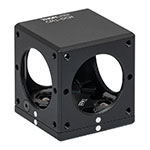 |
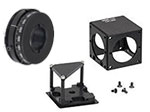 |
| Rectangular Dichroic Mirrors and Filters | Empty Compact 30 mm Cage Cube |
| Posted Comments: | |
user
(posted 2018-04-11 00:09:17.537) I would like to have answer on asg's question:
asg (posted 2016-07-07 15:03:31.133)
Dear Thorlabs, We are designing a setup for which we would like to know if the 30 mm Cage Cube-Mounted Circular Polarizers number VC5-532/M can be used. Here is the Setup we are using: Source of light; Polarizer (parallel polarization); Wave plate (Circular polarization); Sample. We set a detector next to a side output face of the polarizer to measure the intensity which is reflected by the sample. We would like to know if the 30 mm Cage Cube-Mounted Circular Polarizers can reflect ALL light from the sample into the detector without transmitting any light back to the source (through the input face). P-polarized light is incident on the and the Cube-Mounted Circular Polarizers is set to produce circular polarized light. The Circular polarized light is hitting a sample at normal incident and reflected back and pass through the Cube-Mounted Circular Polarizers again. The question is how does the light leave the Cube-Mounted Circular Polarizers after it second entry? Regards, Astel GUISSE nbayconich
(posted 2018-04-12 01:31:44.0) Thank you for your feedback. The cube will have a transmission and reflection related to its input polarization state, so unless the light re-entering the cube is 100% S polarization state, there will be a component transmitted, and not all of it will be reflected.
In other words Say your input polarization at the PBS cube is 100% P polarized and your fast axis of your quarter waveplate is aligned at 45° relative to the polarization plane of your P polarized source, light passing through the quarter waveplate will turn into circularly polarized light and then upon reflection will undergo a 180° phase shift change the handedness of the circular polarization.
After passing through the quarter waveplate again the Circularly polarized light will change back to linearly polarized light but this time it should be S polarized causing the returning beam to be reflected off of the Polarizing beam splitter cube. If your quarter waveplate is not aligned exactly you may create an elliptical state that would cause some transmission and reflection. asg
(posted 2016-07-07 15:03:31.133) Dear Thorlabs,
We are designing a setup for which we would like to know if the 30 mm Cage Cube-Mounted Circular Polarizers number VC5-532/M can be used.
Here is the Setup we are using:
Source of light; Polarizer (parallel polarization); Wave plate (Circular polarization); Sample.
We set a detector next to a side output face of the polarizer to measure the intensity which is reflected by the sample.
We would like to know if the 30 mm Cage Cube-Mounted Circular Polarizers can reflect ALL light from the sample into the detector without transmitting any light back to the source (through the input face).
P-polarized light is incident on the and the Cube-Mounted Circular Polarizers is set to produce circular polarized light. The Circular polarized light is hitting a sample at normal incident and reflected back and pass through the Cube-Mounted Circular Polarizers again.
The question is how does the light leave the Cube-Mounted Circular Polarizers after it second entry?
Regards,
Astel GUISSE olivier
(posted 2015-09-22 16:49:14.52) Thank you Bweh for your answer. Actually, my goal was to perform a test of calibration of my polarimeter using the circular polarizer. When I read that the circular polarizer is prealigned so that the outputted light has a right-handed circular polarization, I am expecting to measure V = +1 with the polarimeter. But instead of V= +1, I have measured V= -0.57 ! How can I re-aligned correctly the quarter-wave plate of the circular polarizer? Do I have to send it back to the factory? Thank you. besembeson
(posted 2015-09-28 11:00:00.0) Response from Bweh at Thorlabs USA: Thanks for the follow-up. We will check the rest of our stock items to ensure that the output is as expected. You can optimize the alignment by rotating the quarter waveplate that adjusts the orientation of the p-polarized transmission through beamsplitter relative to the waveplate's principal plane while monitoring that Stokes parameter using a polarimeter. An un-polarized or a p-polarized source at the correct wavelength should be okay. You may also send this to us to re-align. I will follow-up with you. olivier.poch
(posted 2015-09-22 11:15:02.03) Dear Sir or Madame,
In the "Polarization Control" section it is stated that "The cubes are shipped with the rotation mount prealigned and locked so that the outputted light has a right-handed, circular polarization".
What is the guarantee on this factory calibration?
Using a Stokes Polarimeter, I have measured the polarization of the light produced by a randomly polarized 633 nm laser when it goes through the circular polarizer still locked at factory position. I have measured a V = -0.57308 +/- 0.00066. Thank you. besembeson
(posted 2015-09-22 08:12:14.0) Response from Bweh at Thorlabs USA: Thanks for your feedback. The alignment that we do in the factory is more of a coarse alignment and markings are for reference. This can indeed be optimized with a polarimeter like you have measured for your application. dietrich
(posted 2013-11-28 06:39:11.9) Dear Madame or Sir,
could you please provide me with a solution to obtain circular polarization for a 976nm/150mW CW Single Mode Laser?
Kind Regards
Philipp Dietrich tcohen
(posted 2013-12-05 02:54:15.0) Response from Tim at Thorlabs: Thanks for your request. We will contact you via email with a quote. |
Beamsplitter Selection Guide
Thorlabs' portfolio contains many different kinds of beamsplitters, which can split beams by intensity or by polarization. We offer plate and cube beamsplitters, though other form factors exist, including pellicle and birefringent crystal. For an overview of the different types and a comparison of their features and applications, please see our overview. Many of our beamsplitters come in premounted or unmounted variants. In this tab is a complete listing of our beamsplitter offerings. To explore the available types, wavelength ranges, splitting/extinction ratios, transmission, and available sizes for each beamsplitter category, click More [+] in the appropriate row.Plate Beamsplitters
| Non-Polarizing Plate Beamsplitters |
|---|
| Polarizing Plate Beamsplitters |
|---|
Cube Beamsplitters
| Non-Polarizing Cube Beamsplitters |
|---|
| Polarizing Cube and Polyhedron Beamsplitters |
|---|
Pellicle Beamsplitters
| Non-Polarizing Pellicle Beamsplitters |
|---|
Crystal Beamsplitters
| Polarizing Crystal Beamsplitters |
|---|
Other
| Other Beamsplitters |
|---|

| Table G1.1 Specifications | ||
|---|---|---|
| Item Version | Imperial | Metric |
| Beamsplitter | ||
| Extinction Ratioa | Tp:Ts > 3000:1 | Tp:Ts > 1000:1 |
| Surface Quality | 40-20 Scratch-Dig | |
| AR Coating Reflectance (@ 0°AOI) | <0.25% per Surfaceb | <0.5% per Surfacec |
| Transmitted Wavefront Error | λ/4 @ 633 nm (rms) | |
| Material | UV Fused Silica | N-SF1 |
| Wave Plate | ||
| Retardance Accuracy | λ/300 (Typical) | |
| Surface Quality | 20-10 Scratch-Dig | |
| Reflectance | <1.00% at Design Wavelength | |
| Transmitted Wavefront Error | λ/8 @ 633 nm (rms) | |
| Assembly | ||
| Output Polarization (Through Waveplate) | λ/4 ± λ/100 at Design Wavelength | |
| Transmitted Beam Deviationd | ±10 arcmin | |
| Reflected Beam Deviationd | 90° ± 20 arcmin | |
| Outer Dimensions | 1.50" × 1.50" × 1.50" (38.1 mm × 38.1 mm × 38.1 mm) |
|
| Clear Aperture | Ø10.0 mm | |
| Cage Cube Material | Anodized Aluminum | |
| Mounting Hole | 8-32 Tapped Hole | M4 Tapped Hole |
- Design Wavelengths: 532, 633, 780, 1064, or 1550 nm
- Antireflective (AR) Coatings
- Imperial: Rabs < 0.25% @ 0° AOI
- Metric: Ravg < 0.5% @ 0° AOI
- Beamsplitter Extinction Ratio
- Imperial: Tp:Ts > 3000:1
- Metric: Tp:Ts > 1000:1
Thorlabs' Variable Circular Polarizing Cubes are constructed of a quarter-wave plate in a rotation mount and a 1" polarizing beamsplitter cube housed in a 30 mm cage cube. Together, they can generate circularly, elliptically, or linearly polarized light.
The imperial versions of these variable circular polarizers feature laser-line beamsplitter cubes with a 3000:1 extinction ratio and Rabs <0.25% per surface at the design wavelength. The metric versions are equipped with broadband beamsplitter cubes that offer an 1000:1 extinction ratio and
| Damage Thresholds | |||
|---|---|---|---|
| Item # | Design Wavelength |
Unmounted Cube Item # |
Damage Threshold |
| VC5-532(/M) | 532 nm | PBS25-532 (PBS251) |
2 J/cm2 at 532 nm, 10 ns, 10 Hz, Ø0.803 mm |
| VC5-633(/M) | 633 nm | PBS25-633 (PBS251) |
2 J/cm2 at 532 nm, 10 ns, 10 Hz, Ø0.803 mm |
| VC5-780(/M) | 780 nm | PBS25-780 (PBS252) |
2 J/cm2 at 810 nm, 10 ns, 10 Hz, Ø0.166 mm |
| VC5-1064(/M) | 1064 nm | PBS25-1064 (PBS253) |
2 J/cm2 at 1064 nm, 10 ns, 10 Hz, Ø0.484 mm |
| VC5-1550(/M) | 1550 nm | PBS25-1550 (PBS254) |
5 J/cm2 at 1542 nm, 10 ns, 10 Hz, Ø0.181 mm |

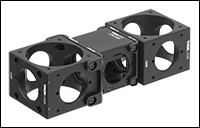
Click to Enlarge
Figure 437B A C4W and C6W Cage Cube connected to a 1.5" wide
CCM1-4ER Compact Cage Cube using the C4W-CC and CM1-CC Cube Connectors, respectively.
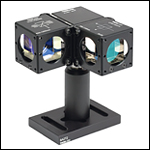
Click to Enlarge
Figure 437A CM1-CC Cage Cube Connector Connecting Multiple 1.5" Wide Cage Cubes
- Connect Two 1.5" Wide Cage Cubes Side by Side
- Connect a 1.5" Wide Cage Cube to a 2" Wide Cage Cube
- Compatible with CM1 or CCM1 Series Cage Cubes
The CM1-CC cage cube connector allows two or more CM1 or CCM1 style cubes to be connected as shown in Figure 437A. The CM1 and CCM1 series of cage cubes, which are all compatible with this connector, include empty cubes, empty dichroic cubes, mounted beamsplitters, mounted penta prisms, and mounted turning mirrors. The CM1-CC cage cube connector includes four 4-40 button-head screws, two 4-40 flat-head screws, four washers, and a 1/16" hex key.
Two cage cube-mounted turning mirrors cannot be connected using the CM1-CC due to a lack of Ø6 mm cage rod holes on two sides of the cube.
We also offer the C4W-CC to connect two 2" wide 30 mm cage cubes. Both C4W-CC and CM1-CC cage cube connectors can be used to connect one 1.5" wide 30 mm cage cube, such as our CCM1-4ER(/M), with a 2" wide 30 mm cage cube.
Alignment Pins
Please note that because dowel alignment pins are used, the connector requires drilled holes on the cube face between the SM1-threaded (1.035"-40) ports. If you have an older cube and would like it updated to have alignment holes for free, please contact Technical Support. Alternatively, the alignment pins are press-fit inside their mounting holes, and can be pressed out for use with cubes that do not have these alignment holes.
 Products Home
Products Home











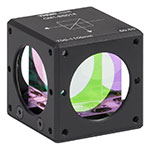
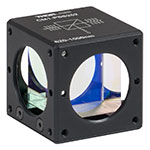
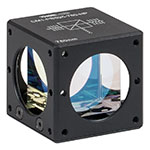
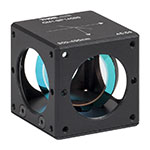
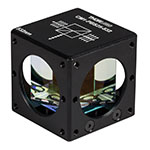
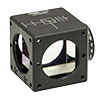
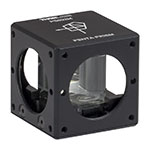
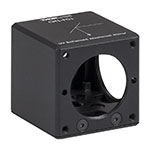
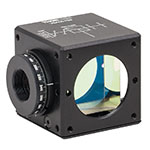
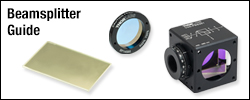
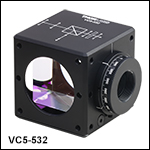
 Zoom
Zoom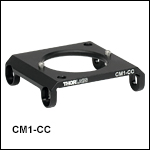
 Variable Circular Polarizer
Variable Circular Polarizer